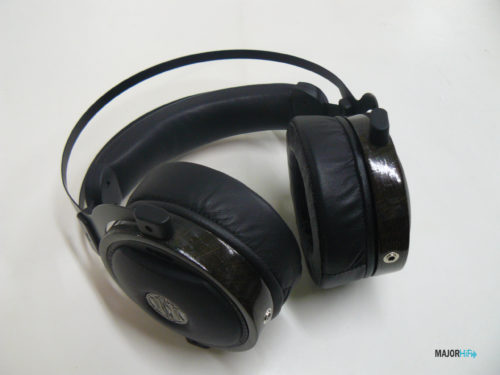My last review took a look into the Kennerton Gjallarhorn GH 50 JM, a closed-back headphone rising in popularity in the audiophile community. In the review, I praised the model for its unique build and expansive soundstage. The imaging contained an amount of depth so engrossing that it almost stretches beyond the label of a closed-back principle. The sound signature features some excellent qualities as well and is actually a complete retuning of a different headphone. However, this headphone is actually the same headphone by name and look.
I reviewed the JM edition of the GH 50 model, so there’s another just like it, but with a completely different timbre. This was the original version before John Massaria modified the acoustic makeup of the horn driver. Kennerton thought the changes were substantial enough to officially release this mod as a “workshop” version of the GH 50. So what exactly are the differences between both headphones? Let’s analyze how each of them operates in frequency response and overall sound signature.

What You Get
Each set of Gjallarhorn GH 50s, whether it is the standard or JM edition, comes packed with the same items. With both headphones, you’ll find an eco-leather storage case with its cable wrapped inside. The cable is a quarter-inch jack with dual 3.5mm rhodium-plated connectors. The case stores the headphones in a nicely padded interior, although it is rather large and not as easy to pack. I can’t see people carrying these cases around like a bag outside, but it’s nice that Kennerton kept the option in mind.

Look and Feel
Eyeing both headphones will pretty much tell you immediately that both versions of the GH 50 are identical on the outside. Each pair will feature the same build, with wooden ear cups, lambskin leather pads, and a suspension headband with metal frames. With the same construction, both headphones run into the same issue with the headband. Many have reported that the metal band must be bent in order to obtain the ideal fit for both GH 50 models. Although the fit can be light and comfortable without the bend, they might not feel as secure as they should be. The bend will help tighten fit and will most importantly do a better job with communicating the intended sound signature.

Design
This is where we start to talk about some real key differences. Other than the 50mm horn driver, and graphene diaphragm, the acoustic makeup of the housing configuration has some major tweaks. Massaria himself explains a lot of the process himself, talking step by step on how exactly he modded the GH 50. You can read all about it yourself, but to sum it up, Massaria takes the area right above the graphene membrane and places fabric dots around the outside. This is a specific process accomplished with precision, with no room for error, or else the driver can be easily ruined. The goal here is to alter where the frequencies are accentuated as the standard GH 50 has a timbre that has its preferences in texture and detail.

Soundstage
Both GH 50 headphone variations have been applauded for their soundstage, but they have some key differences. Although the standard GH50 has a similar amount of separation and depth as the JM edition, I felt that the JM appeared a bit wider in comparison. The width of the JM edition extends the space almost to an extreme degree for a closed-back headphone, and with the same amount of depth and separation, the imaging of the JM becomes this undeniable immersive sound field. While the standard version is just as spacious, the JM just feels like it goes beyond the limit. This was immediately prevalent with live recordings. When listening to the live recordings of a classical performance, the instruments appeared a lot more accurate to the source on the JM, and the reflections of the space are a lot more discernable. Whichever way you see it, both versions are a triumph in closed-back soundstages.
Low End
The bass is definitely a standout in both headphones but for completely different reasons. With the JM edition, the bass was a major focus on the restructuring of the sound signature. The main point here is emphasis. The standard GH 50 provides a gripping amount of punch and impact to the sound signature, and forms this massive tonality in the lows that’s clear and engrossing. In comparison, the JM edition takes that low-end punch and tightens up the resonance for a more natural timbre. The tonality is much smoother and doesn’t extend as much as the standard GH 50. However, the separation and clarity are a lot more well defined on the JM edition, with details that become more noticeable without sacrificing the feel of the sub-bass.
Mids
Midrange frequencies present some of the most interesting contrast on both headphones. The GH 50 has a big midrange, with the frequencies forming a solid body. In effect, this gives the mids a rich timbre that exudes a lot more warmth than the JM edition. Even though I’ve been a fan of warm headphones in some cases, the more spacious and balanced tonality of the JM edition highlighted the details a lot better. This tuning made the headphones crisper in the mids without sacrificing much of the weight. With the more spacious tonality, instruments and effects are a lot more articulate and provide more dynamic frequencies.
Highs
Treble is where I found the most immediate differences in the sound signature. The GH 50 has a more recessed treble, but the tonality is still clear as day. The high-end character is reduced for a warmer character, but not a ton of treble fidelity is sacrificed, only the brighter frequencies. This works for the timbre the GH is going for, but the JM edition speaks more to my tastes. With the JM edition, the highs are going to have a lot more character. Certain instruments will contain a lot more sizzle, and taper off with an extended tail. The tuning here is very emphasized, but it never feels too overblown. Instead, the highs fill out the sound signature with an elegant finish, making for a more musical tonality.
Summary
While both headphones look the same on the outside, they couldn’t be more different on the inside. The GH 50 and GH 50 JM are both excellent closed-back headphones, some of the best available today. Each model houses a different n character of timbre, so there’s bound to be a sound for you if you don’t want to miss out on Kennerton. The JM edition spoke better to me, with its balance and high-frequency coloration, but if you prefer more bass with a darker texture, the standard GH 50 should do the trick.
The Kennerton Gjallarhorn GH50 and GH50 JM are available at Audio 46.
Discuss the Kenenrton Gjallarhorn GH50 and GH50 JM on our forums here.
Compare the ranking of various headphones, earbuds and in-ear monitors using our tools.
Discuss this, and much more, over on our forum.
---MAJORHIFI may receive commissions from retail offers.















